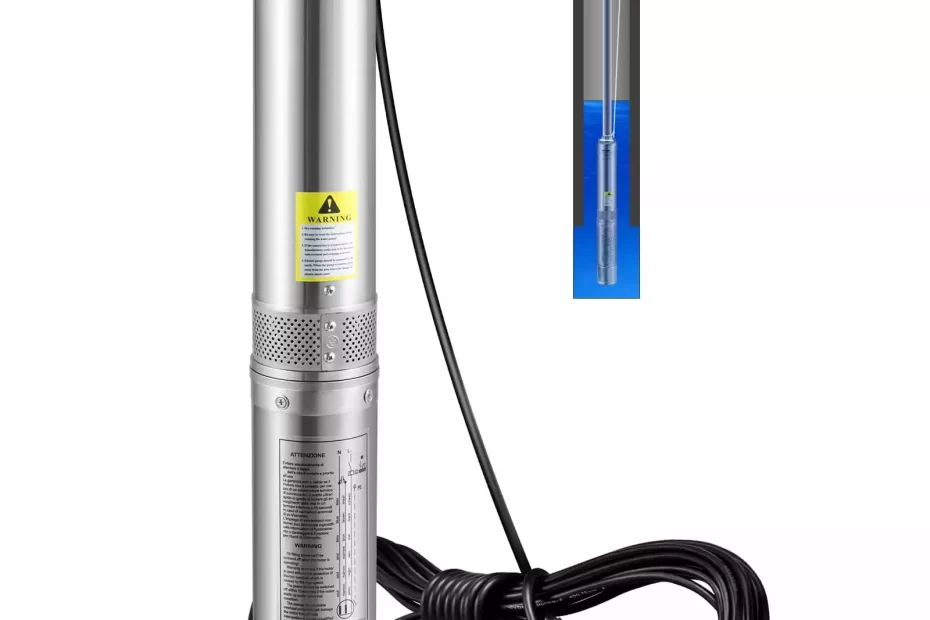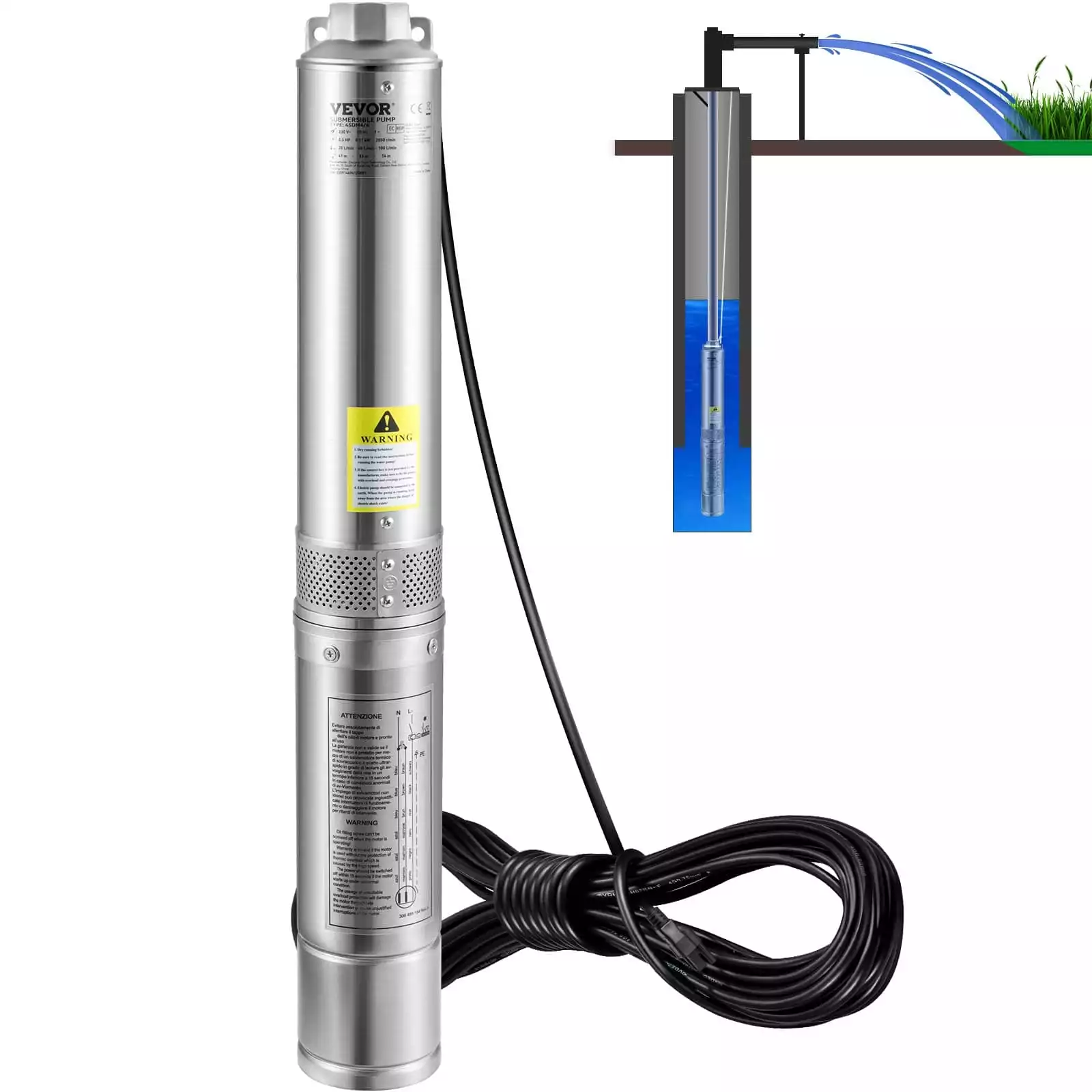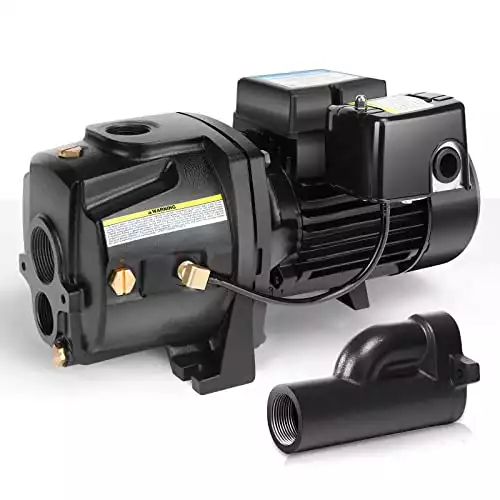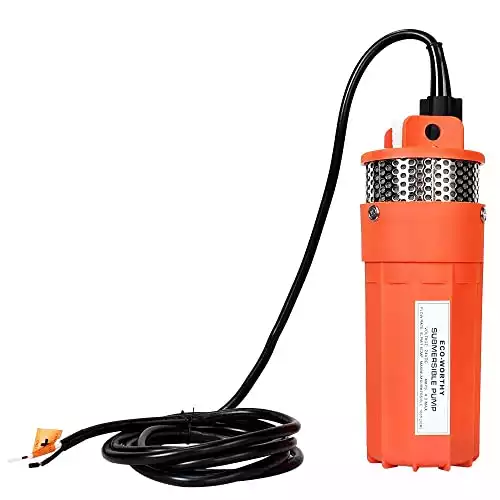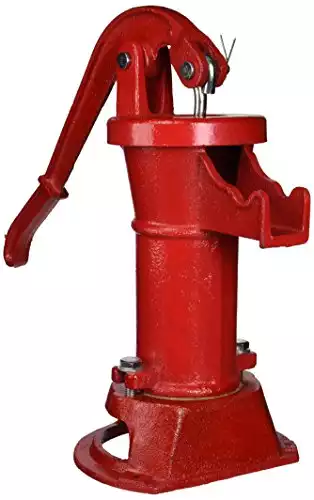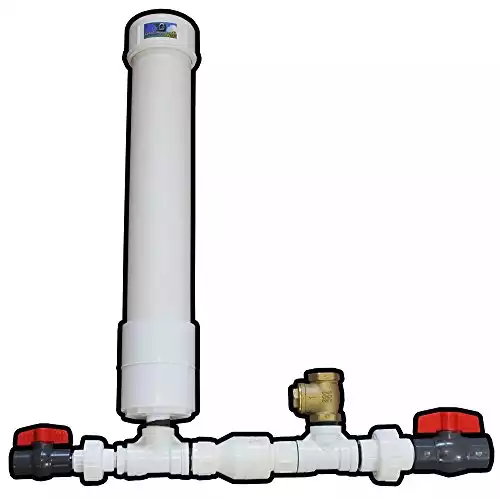[ad_1]
An off-grid water pump is a crucial part of the homestead. The best one for you will depend on your power supply, water source, and budget.
I’ve run the gamut of water pumps, examining their functionality and performance in various off-grid scenarios. After factoring in the cost and capabilities of each product, I’ve compiled a list of the five best off-grid water pumps on the market.
Each one fills a specific niche, so read on to discover the best water pump for your unique situation.
Our Top Pick
Vevor Deep Well Submersible Pump
With a stainless-steel body and pure copper motor, the VEVOR Deep Well Submersible Pump is tough as nails and built to last. It’s a powerful and efficient pump serving many different applications, and the affordable price tag makes it an accessible investment for most people.
Best Surface-Level Pump
Acquaer Well Jet Pump
Made of solid cast-iron with a compact yet powerful engine, the Acquaer Convertible Jet Pump is your best bet for both shallow and deep wells. Its dual-voltage system ensures you can use it anywhere, while extra features, like built-in heat protection, add extra value to sweeten the deal.
Best Off-Grid Water Pump Reviews
1. Best Overall: VEVOR Deep Well Submersible Pump
Specs:
- Horsepower: 1 HP
- Power draw: 750 W
- Volts: 230 V AC
- Max flow rate: 37 GPM
The VEVOR is a capable pump with a low-maintenance design that’s perfect for off-grid homesteads and farms.
VEVOR is a premium brand offering superior products, and this submersible pump is no exception. It works in wells larger than four inches in diameter and delivers up to 207’ of vertical lift. The impressive 37 GPM flow rate is sufficient to provide your household with water, irrigate your land, and keep thirsty livestock hydrated.
The VEVOR isn’t limited to wells. You can use it in rivers, reservoirs, ponds, or anywhere you need. Provided it will sit comfortably beneath the water’s surface, you should be good to go. If you have shallow water, you can get wild and install it horizontally.
This pump is built with anti-corrosion stainless steel, so you won’t have to bring it up for repairs constantly. You’ll save both time and energy thanks to its built-in check valve, overheat protection, and high-efficiency motor.
However, this 750-watt pump does require a bit of power to start up and run. With that in mind, it may be better suited for well-developed off-grid power systems.
It takes 230 volts of AC power, so those using solar panels will need an inverter. This can get pricey, but you’re buying a system for life. The VEVOR far outshines other well pumps in terms of capability and quality, so homesteaders in it for the long haul will be better off with this puppy as time goes on.
Pros
- Extremely reliable
- Good-quality materials
- Superior flow rate
Cons
- Draws lots of power
- May require inverter
2. Best Surface Pump: Acquaer Convertible Jet Pump
Specs:
- Horsepower: ½ HP
- Power draw: 750 W
- Volts: 115 or 230 V AC
- Max flow rate: 18 GPM
The Acquaer is a convertible pump with a convenient dual-voltage system that effectively serves both shallow and deep wells.
The Acquaer convertible jet pump works for single and double-piped well systems, so it’s suitable for shallow and deeper wells up to 90 feet. It has an impressively powerful 1⁄2 hp engine and runs on both 115 volts and 230 volts of AC power successfully.
The ability to switch the voltage means you can use it practically anywhere, no matter the voltage of your power supply. This can give you more control over energy consumption and location, making it ideal for off-grid power systems.
You can move this baby around wherever you need, whether that’s the barn, the kitchen, or your kid’s inflatable swimming pool.
Learn how the Acquaer works and functions in different applications.
Since the Acquaer is a surface pump, it isn’t submerged inside your well. This makes it easier to transport and access for repairs, but its solid cast-iron volute body ensures it will last for quite a while. It’s not a cheap pump, but its versatility means it can adapt to an evolving homestead and serve you for years to come.
You also get extra features, like built-in heat overload protection and an automatic pressure switch. This protects your investment and ensures you always have water in your storage tank. Unfortunately, the GPM depends mainly on your well depth, and some users have reported lower flow rates than those advertised.
Pros:
- Portable
- Shallow or deep wells
- Dual voltage
Cons:
- GPM highly variable
- Expensive
3. Best Budget Pump: Eco-Worthy Submersible Pump
Specs:
- Horsepower: 0.13
- Power draw: 96 W
- Volts: 24 V DC
- Max flow rate: 1.6 GPM
The Eco-Worthy is a steadfast solar pump best for budget-minded buyers with deeper wells.
The Eco-Worthy is a submersible pump specially designed to work with solar power systems. It runs off 24 V DC power and has a low wattage, making it extremely energy efficient and highly versatile. The pump can connect directly to panels or run off stored energy from a battery bank. Many users have reported powering it via a boat engine or other creative methods.
This is a great little pump for those on a budget, rivaling other solar well pumps in terms of energy efficiency and convenience.
The Eco-Worthy will deliver up to 100’ of lift for those with deeper wells, but the output isn’t optimal. At just 1.6 GPM, you’ll definitely need to have a water reserve tank. You’ll also need to closely monitor your levels, as the Eco-Worthy does not have a pressure sensor.
Discover how one homesteader uses his Eco-Worthy pump to lift water from a lake.
Additionally, running it directly off PV panels may cause problems. Shortages and power fluctuations can damage your panels and potentially leave you without water.
It’s wise to run your water pump off a battery bank to protect your investment. At the very least, have a battery bank reserve. That way, you can configure your system to switch over automatically as needed.
Pros:
- Designed for solar
- Inexpensive
- Low power draw
Cons:
- Low flow rate
- Spotty customer service
4. Best Manual Pump: Simmons No. 2 Pitcher Pump
Specs:
- Human power
- Nonelectric
- Max flow rate: variable
The Simmons is a hand-powered pump that delivers lifesaving water regardless of your power supply.
You never know what’s going to happen on the homestead. What if your off-grid power gets cut off? You don’t want to be left without water in an emergency.
Where electric pumps fail, the Simmons manual pump doesn’t. You can use it as a standalone system or install one alongside an electric well pump.
Read: How to pump water from a well without electricity
Learn how to install a pitcher pump quickly and easily on your homestead.
This pump works with your own strength. You press the pump lever, creating suction. The suction draws water up from your source and pushes it through piping to your home or garden. Since the Simmons relies on hand power instead of horsepower, you can always use elbow grease to get your water.
The Simmons No. 2 Pitcher Pump is the perfect manual pump for water cisterns, tanks, ponds, and wells up to 25 feet deep.
It’s an affordable option that’s easy to install, and it’s made from durable close-grain cast iron to ensure long operating life without excessive maintenance or repairs. You might have to lubricate it every once in a while, but that’s a small price to pay for peace of mind.
The Simmons has an adjustable cap for different positions, and buyers have widely reported it’s easy to prime and use. It’s one of the better hand pumps on the market, and its mid-range price ensures that most people can afford it.
The only downside is that the Simmons is not suitable for deeper wells. It also requires some strength to get it going, and you’ll need to have a few cups of water on hand to prime it first.
Pros:
- Nonelectric
- Inexpensive
- Pioneer vibes
Cons:
- Elbow grease
- Regular grease
5. Best for Flowing Water: Land to House Hydraulic Ram Pump
Specs:
- Waterpower
- Nonelectric
- Max flow rate: 4 GPM
The Land to House pump works without electricity and provides impressive flow for those relying on creeks and rivers.
Many off-grid homes don’t have a well at all. If you rely on a river, stream, or creek to get water, you still need to pump that water up to the house.
You could use an electric pump, but why bother? You can use a hydraulic ram pump instead. This Land to House pump relies on pressure from a flowing source to pump water up to where it’s needed.
Learn exactly how a ram pump works to determine if it’s the right system for you.
Will it work on your homestead? That depends.
This pump needs a two-foot drop to provide a bit of head pressure and get the water flowing. You need to install it after a waterfall or downstream of a hill in your creek.
If you don’t have any drop, it won’t work. The pump can put out three or four GPM, but functionality will vary depending on head pressure and the distance you’re piping the water.
Land to House is a smaller business that provides excellent customer service and transparent information on what its products can and can’t do. However, it isn’t cheap.
Despite rave reviews, this pump can be inaccessible for some people because of the price. If you feel confident in the plumbing department, you can build your own hydraulic ram pump for less money.
Pros:
- Nonelectric
- Low maintenance
- Impressive flow
Cons:
- Expensive
- Requires two-foot drop
- Requires flowing source
Off-Grid Water Pump Buyer’s Guide
To determine the type of off-grid water pump you need, think about your water source and power supply.
Various types of well pumps are available for standard well setups, but those who draw water from surface sources may want alternative products.
Different pumps suit different off-grid situations, and it’s important to consider your unique circumstances when selecting your pump.
Submersible Pumps
Submersible pumps sit deep inside your well below the waterline. They are a type of centrifugal pump with a sealed motor, an impeller system, and a pressure switch. When you trigger the pressure switch, the engine draws water through its impeller system and pushes it to the surface of your well.
Submersible pumps are the best option for deep wells, but you can also use them successfully in shallow wells, rivers, and ponds. You don’t have to prime them and they are usually more energy efficient than other pumps because they already sit in the water.
These pumps push liquid to the surface rather than suck it from the ground, which takes less force and uses up less energy.
Learn how submersible pumps work and discover some of their advantages compared to other pumps.
Submersible pumps are great for off-grid homesteads because of their extreme efficiency, but they are harder to maintain. Working on them while they are submerged is impossible, so you need to pull them up first. If they are hundreds of feet below the ground, this can be a hassle.
However, a good one like the VEVOR will be less prone to malfunction in the first place.
Some submersible pumps can last up to 25 years before you need to work on them. By choosing a high-quality product, you’re basically buying yourself that chunk of time. Plus, you get peace of mind knowing your machine won’t break on you when you need it most.
Surface Pumps
Surface pumps sit above the waterline, usually in your wellhouse. Like submersible pumps, most surface pumps are centrifugal pumps. However, some of them have a jet component added on.
A surface centrifugal pump uses an engine and impeller system to create pressure and suck water up through your well shaft. They work in wells less than 25’ deep, and many are designed to be portable.
These pumps are easy to move and use throughout the property. You can draw up water from a shallow well, pond, or creek, then use the same pump to distribute it from your pressure tank to the garden.
Simple surface pumps are generally less expensive than submersible pumps, but there’s only so much they can do. To increase utility, manufacturers have started adding jet components to them.
Learn about the different kinds of jet pumps to find out if a certain product will be better for your system.
A jet pump is a type of centrifugal pump that creates additional suction power via a jet. The jet component can be separated from the impeller system and placed inside the well shaft to reach deeper underground.
The Acquaer Jet Pump on this list is such a great product because it can be converted from a shallow well pump to a deep-well pump. It takes full advantage of centrifugal power, adding in the jet component at whatever depth you need.
If you decide to install a jet pump, keep in mind that they are not as energy efficient as submersible pumps. However, they will be easier to access and work on. A convertible jet pump can also be moved more easily and used for different applications, making it a more versatile option.
Manual Pumps
A manual pump does not require any electricity at all. Instead of a motor, it relies on the power of your arm to pump water to the surface. This makes it a great off-grid option, but these pumps can be difficult to operate because they require more physical strength.
Like the Simmons on this list, most manual pumps only work in wells up to 25’ deep.
You can special-order them for deeper wells, but it can get costly.
If you have a shallow well or can afford to order a custom manual pump, I say go for it. Even if it’s just a backup, having a hand pump can save your life, your animals, and your garden in an emergency.
Read: How to install a hand pump into an existing well
Hydraulic Ram Pumps
A hydraulic ram pump like the Land to House model works on water power and gravity. Liquid flows into the pump, travels downward, and creates pressure at a stop-valve.
The pressure pushes water up through the pipe, delivering it wherever you need. A hydraulic ram pump can provide running water without electricity, but installing one inside a pre-dug well is impossible.
Learn how to make your own hydraulic ram pump. A detailed video, but well worth a watch!
To use gravity and create pressure, you need flowing water and a drop in grade.
This means hydraulic pumps only work in certain situations, but they’re amazing when the conditions are right.
Cost-conscious homesteaders will be thrilled with a hydraulic ram pump because they’re inexpensive, easy to work on, and simple to fix with commonplace parts.
Factors to Consider
Well Diameter
Do you take water from a well?
If you’re buying a submersible pump, check the diameter of the pump against the size of your well shaft and leave yourself some wiggle room.
You need at least one inch of clearance between the well casing and the shaft. That means a 5” shaft opening should house a well casing no more than 4” in diameter.
Flow Rate and Lift
The rate at which water flows from your source up through your pump is measured in gallons per minute, or GPM. However, you’ll sometimes see the flow rate measured in gallons per hour (GPH). You can divide GPH by 60 to determine the GPM measurement.
You’ll often see GPM labels stating a maximum flow rate. Remember that the maximum flow rate does not necessarily dictate the actual flow rate.
There is an inverse relationship to the flow rate and lift. The higher your pump has to lift the water, the less GPM it will output. So with deeper wells, you lose GPM.
Water Requirements
The typical household needs between 6–12 GPM to meet the water demands of everyone inside. A flow rate of 6 GPM should work for a one-bathroom household, while 8–10 GPM is better for multiple bathrooms. If you have animals or a large garden, you may need 12 or more GPM. A good rule of thumb is that you’ll need eight additional GPM for every acre of crops.
What if your well or pump isn’t capable of delivering that much water? Most water systems have a pressurized holding tank that stores pre-pumped water. The pump automatically kicks on and fills up the tank when the water falls below a certain level.
This type of setup works well, and many pumps are already compatible with a pressure-tank system like this. However, you don’t need a specialized system to take advantage of your water source. You can simply get some water storage containers to hold your water.
Power Supply
Unfortunately, most pumps require electricity to run. That doesn’t mean off-grid homes can’t use them, it just means you have to be mindful of the power draw. You can use a generator, solar power, or any number of sources to provide electricity to your pump. It just depends on how creative you want to get.
Generators and solar systems are probably the most common ways to power an off-grid water pump. If you have panels, you may have to tweak your solar system to make it compatible with your pump. Solar panels generate DC power. If your pump runs on AC, you’ll need an inverter to convert DC energy to AC.
Learn about different types of solar inverters to decide what kind of device you might need.
Most pumps run on AC, and solar users shouldn’t discount them just because of the power source. An inverter is a pretty standard part of a solar setup.
Generally, AC well pumps that run less than 2 hp can be converted easily to solar. When you move up beyond 2 hp, it gets expensive in terms of conversion parts. That’s when it’s time to start thinking about a specialized solar pump.
Specialized solar pumps already run on DC power, eliminating the need for an inverter. In some cases, solar pumps can connect directly to the PV and don’t draw from the battery bank.
This is more energy efficient and can reduce your power consumption even further, but it requires ideal conditions. Unless you’re living in the Bahamas, it’s unlikely you’ll get good sun every day. For this reason, I don’t recommend using direct-connect pumps without any battery backup.
Electric Demands
Your power supply must meet the electric demands of your pump. You might think you can run a 1,000-watt water pump on a 1,000-watt generator, but you’d be wrong. You need to consider the running power versus the surge power.
The running power is the wattage that your appliance draws. The surge power is the wattage your appliance takes to power on, kick in, and get moving.
The rule of thumb is that you need double the running wattage of an appliance to account for surge power. That means for a 750-watt pump, you would need at least a 1500-watt generator or inverter.
Read: How many watt generator do I need
Wrapping Up
A solid off-grid water pump can take your homestead from zero to hero in the blink of an eye. For deeper wells and more extensive water needs, you can’t beat the energy-efficient VEVOR. If you have a shallow or mid-range well, the versatile Acquaer is your best bet.
Of course, pump requirements vary depending on your off-grid setup. But in most situations, you’ll be able to move your water with one of these products.
[ad_2]
Source link
